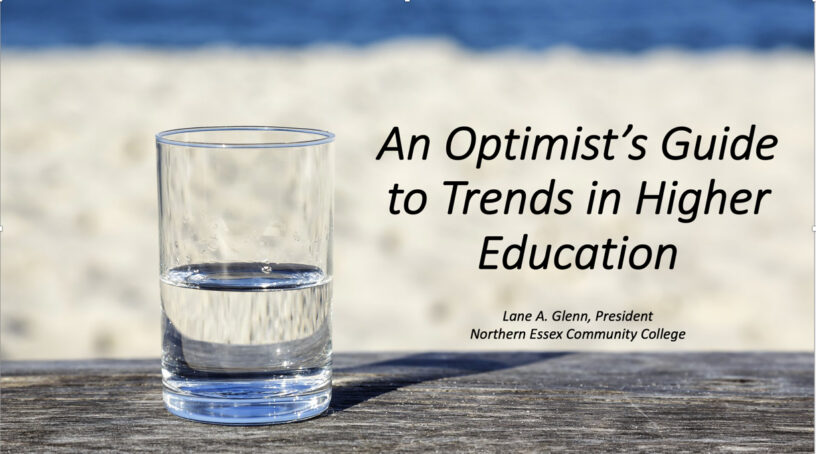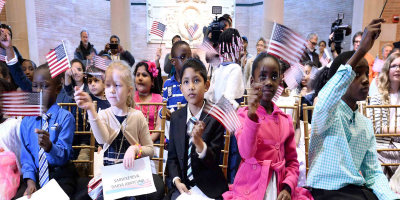For most of us working in higher education, the past two years have delivered more shocking events and rapid changes than at any other time in our lives and careers: The COVID-19 global pandemic, America’s democracy under assault, the murder of George Floyd and a reckoning with our nation’s history of systemic racism, another recession and an ever-widening wealth gap, shifting demographics and enrollment declines, the Russian invasion of Ukraine, battles over Critical Race Theory, attacks on free speech (from both ends of the political spectrum), and much, much more.
If you want to look for the struggles and problems on college campuses, and all around us, you’ll find them easily enough.
As bleak as things may sometimes seem, though, the past two years have also shown us incredible acts of educational heroism, amazing student resiliency, and promising breakthroughs in technology, teaching, and learning with the potential for powerful, positive, and lasting improvements in student success.
Yes, we need to pay attention to problems and crises and find ways to fix them, improve them, avoid them, or eliminate them.
And we need to be just as mindful of the important positive things that are happening, especially on and around our college campuses and with our students, so that we can build on them, play to our strengths, and overcome our challenges.
With that spirit of hopefulness in mind, here is an “Optimist’s Guide to Trends in Higher Education” today:
Student Success

Here is an exciting headline you don’t see often enough: Student completion is improving!
According to the Completing College Report released in February from the National Student Clearinghouse, the share of students who complete a four-year degree within six years improved last year to a decade-long high of 62.2%. Ten years ago, it was only 54.1%.
AND, the biggest boost in completion was at community colleges, which saw 6-year attainment rates increase from 40.7% to 42.2%.
Completion rates improved for White, Black, and Latino students, with the biggest gain, nearly 2%, for Black students.
Rates across the board increased in 32 out of the 46 states for which the Clearinghouse has good data.

Of course, this is important for student success, the economy, the workforce, and college budgets, all of which are helped by improved retention and completion.
Student Support Services
According to the Clearinghouse, the improvements, which began prior to the pandemic, are the result of “students, their advisers and their colleges alike…making long-term adjustments in all the different factors that go into making sure that everyone who starts college has what they need to finish.”
Academic, Financial, and Basic Needs Support
Those adjustments include radical reforms of developmental education, recognizing the importance of mental health assistance, and programs that combine multiple academic, financial, and basic needs support, like the City University of New York’s Accelerated Study in Associate Programs (ASAP) initiative.
ASAP is designed to help associate degree-seeking students earn their degrees as quickly as possible, with a goal of graduating at least 50% of students within three years. It does this by providing individualized course schedules, required full-time study, and comprehensive and personalized advisement and career development services, as well as financial incentives like tuition and fee gap scholarships, assistance to reduce (or eliminate) the cost of textbooks, and unlimited MetroCards for transportation.
The success of ASAP students, which is consistently around 30% higher than non-ASAP students at CUNY, has inspired similar programs in other parts of New York, as well as in Ohio, California, and here in Massachusetts, where the state legislature has provided more than $17 million over the past two years for the Supporting Urgent Community College Equity through Student Services (SUCCESS) initiative at the fifteen community colleges in our state.
What in comes to basic needs, the Hope Center’s #RealCollege Survey, administered annually at colleges and universities around the country, has become one of the most effective tools for advocating for our students. The survey has consistently shown that three out of five college students report struggling with some form of basic needs insecurity, such as hunger or housing insecurity.
In response, colleges around the country have established food and clothing pantries, created special dormitory or community housing arrangements for students who have been displaced from their homes, and more.
Here in Massachusetts, Bunker Hill Community College has put together a comprehensive array of Basic Needs Assistance for their 12,000 students that includes resources for food, housing, transportation, child care, and more. Northern Essex and all of the state’s other community colleges offer similar assistance for students in need.
The message is being heard in Congress and in state legislatures as well. During the pandemic, Congress expanded the Supplemental Nutrition Assistance Program (SNAP) to include college students, and the California State Legislature is considering a pilot project that would pay low-income college students $500 a month to help with their basic living expenses.
Mental Health Support
Another basic need getting a lot of attention right now is mental health support for college students. In the best of times, being a college student is stressful. It goes without saying that the last couple of years have not been the best of times, and several well-publicized surveys over the past year have shown that more than half of college students report feeling regularly depressed, anxious, or worse.
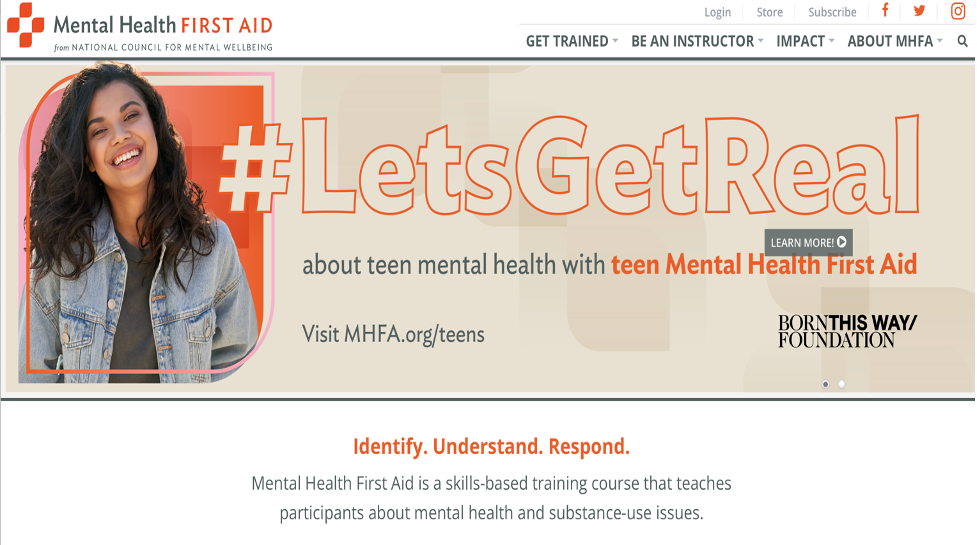
In response, colleges have been adding mental health counseling staff and working with companies like TimelyMD that specialize in providing remote telehealth services specifically to college students.
Northern Essex offers a “Mental Health First Aid” eight-hour training certification that teaches participants how to identify, understand, and respond to signs of mental illness and substance abuse disorders. More than 130 employees of the college have completed the course so far.
When it comes to basic needs like food, clothing, and shelter, and to mental health and well-being, elevating their importance as part of a national conversation is progress. It not only helps to secure desperately needed resources, but also to remove the stigma often associated with these challenges and to increase understanding of them.
Student Access and Enrollment
Let’s manage expectations here right away: According to the National Student Clearinghouse, undergraduate and graduate enrollment has been trending downward across the country since 2012, and the COVID-19 pandemic only made things much worse, especially for low-income students and students of color.
And predictions for the years ahead are not any better: the declining birth rate in America means we are going to have millions fewer 18-year-olds ready to go off to college each year for the next decade, a trend that will especially impact states across the Midwest and in New England.
In 2011, we reached a high of more than 20.5 million college students. Today, there are just over 17 million, over 3 million fewer students enrolled in college in America today than there were a decade ago, and given major demographic changes, unless things change, that number is expected to fall even further over the next ten years.
However, less than half the adult population in the United States has a college degree, leaving an untapped market of well over 100 million people, and colleges, especially community colleges and less selective public universities, are actively opening their doors wider than ever before to high school students, low-income students, and students of color.

So, the somewhat encouraging news about access and enrollment:
- In January, the Common Application reported that unique applicants are up more than 13% over pre-pandemic 2019-20 levels, and the total volume of Common Applications is up nearly 20%.
- Encouragingly, underrepresented students of color increased by 17% and first-generation applicants increased by 21%.
- Public colleges are seeing the biggest gains—24% compared to 17% for private colleges.
Now, the Common App only represents about 900 schools, so the trend may not reach community colleges and less selective public universities—or it may, if we are prepared to act on it.
Transfer Student Enrollment
During the pandemic, transfer enrollment, which is particularly important for the academic mobility of low-income students, first generation students, and students of color, fell dramatically—more than 9% between Fall 2019 and Fall 2020.
Thankfully, according to the National Student Clearinghouse Research Center, it seems to have stabilized this year, dropping less than 1%, or around 11,000 students, in the Fall of 2021.
Early College Enrollment
It is hard to say exactly how many students are participating in some form of dual enrollment or “early college,” programs that provide high school students the opportunity to earn college credit, sometimes as much as an entire associate degree, but the number of states, schools, and students involved is definitely growing—rapidly.
The Government Accountability Office estimates that more than 70% of U.S. high schools now offer some form of dual enrollment credit in partnership with local colleges, and somewhere between 10-30% of U.S. high school students are earning college credits—well over a million each year.
Here in Massachusetts, we are looking to grow Early College tenfold, from just over 4,000 students today to more than 40,000 as soon as possible.
While there are still plenty of challenges to be worked out with Early College programs, the benefits are clear: Early College students are more likely to attend and complete college degrees after high school, especially low-income students and students of color.
And the return on investment for Early College is enormous. In Massachusetts, the public policy organization MassINC has estimated that for every dollar the state invests in Early College it sees a return of $15.
So, without a doubt, higher education still has a challenging road ahead when it comes to access and enrollment, but we also have some glimmers of hope in increased college applications, improving transfer enrollments, expanding early college access, and an opportunity to reach even more people who attend college at lower rates, like first generation students, Black and Hispanic students, rural and low-income students.
Technological Advances
Let’s do a little level-setting here and do some more expectation management up front: Yes, nearly all of higher education moved from classrooms to computers in 2020, but the online and remote teaching and learning that happened over the next two years was not the highest quality, and while a surprising number of students (and faculty) thrived, many more did not.
The return to in-person learning will be a huge benefit to a lot of people.
And…
A lot of students and faculty who may have thought they could never survive, let alone thrive, in an online course or a Zoom room discovered skills they did not know they had, and strategies for teaching and learning that may benefit them for years to come.

Online learning has been a great leveler: In asynchronous courses in particular, introverted students can be as successful as extroverted students. Students with physical disabilities don’t face barriers to the classroom. Students with children, jobs, aging parents, or transportation challenges have more flexible schedules that don’t require commutes.
At the same time, colleges developed new courses, entire new degree programs, and new capacity for online and remote instruction that may be tremendous advantages in the future.
Watch for:
- Continued expansion of online, hybrid, remote and other “flexible” instructional delivery
- More colleges offering more fully online, hybrid, and remote degrees
- Learning management systems integrated into all teaching, including face-to-face
- Expanded professional development for online teaching
- Improved student success in online, hybrid, and remote courses
Credential “Rightsizing”
A recent report from the Federal Reserve Bank of Philadelphia, A Moment of Opportunity: The COVID-Era Job Market for Noncollege Workers, noted an important trend as the nationwide labor market is emerging from the COVID-19 pandemic: There have been far more “opportunity employment” job postings (jobs with a decent wage that do not require college degrees).

In fact, there was a 38% increase in these postings between 2020-2021.
This is a huge shift in the job market, after decades of “credential inflation” during which employers, especially in highly educated, tight labor markets, like in New England, steadily increased minimum credentials for jobs from high school diplomas, to some college or an associate degree, to bachelor’s degrees, and beyond to graduate degrees.
The job market is finally striking back.
A declining fertility rate (already underway, then worsened by two economic recessions in the past decade), a shrinking labor force, and the pandemic have all put more bargaining power into the hands of workers—and 68% of workers in America do not have a bachelor’s degree or higher (78% for Black Americans and 84% for Hispanic Americans).
Employers need workers, and they are ready to relax their requirements.
According the Wellspring Initiative’s November 2021 Digital Credentials and Competency Frameworks report:
- 36% of HR leaders said they are relaxing or eliminating college degree requirements.
- 34% of HR leaders indicated that their organization is operating with a skills-based hiring strategy that focuses more on competency in hiring rather than over-relying on college degrees (an increase from 23% in a similar survey question three years ago).
This has enormous, mostly positive, implications for American workers and for community colleges and less selective universities that are prepared to meet the demand for credentials other than bachelor’s degrees.
Credentialing Options
The Business Roundtable is an association of chief executive officers of America’s leading companies (think Amazon, Best Buy, and Citibank—and those are just the ABC’s) “working to promote a thriving U.S. economy and expanded opportunity for all Americans through sound public policy.”
One of their newest initiatives is “a multi-year, targeted effort to reform companies’ hiring and talent management practices to emphasize the value of skills, rather than just degrees, and to improve equity, diversity and workplace culture.”

They aim to do this by rewriting job descriptions to include the skills the companies most need, then seeking, or developing, people with those skills through short-term credentialing programs like:
- Prior Learning Assessment
- Competency Based Education
- Digital Badges
- Microcredentials
- Stackable Credentials
These are all new avenues of curriculum development and teaching and learning opportunities for enterprising colleges and universities, and new ways to build greater equity into our credentialing processes.
Diversifying Higher Education Leadership
According to an analysis by Inside Higher Ed, in the 18 months following the murder of George Floyd, between June 2020 and November 2021, more than a third—35.4 percent—of the presidents and chancellors that American colleges and universities hired were members of racial minority groups.
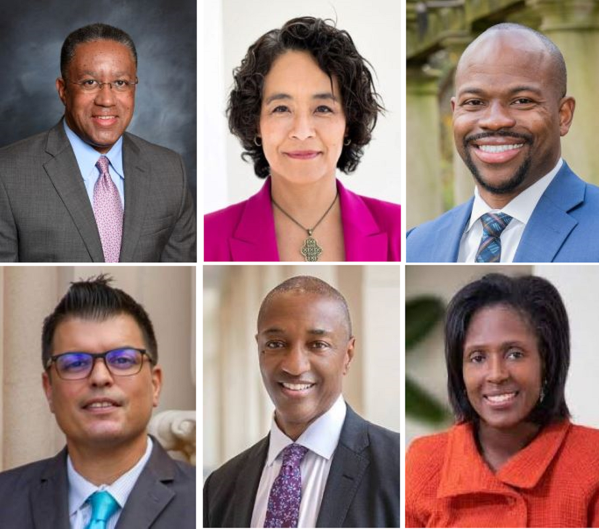
Just over a quarter, 25.3%, were Black.
In the 18 months prior to George Floyd’s death, only 22% of presidential hires were nonwhite, and 14.6% were Black.
The proportion of Latino presidents hired also grew during those 18 months, to 7%, compared to 4% in the previous 18 months.
These are encouraging signs for the acceleration of diversity in higher education leadership at a time when we need it most.
College is Becoming More Affordable

Don’t misunderstand: The cost of college (tuition) still went up last year, but according to the College Board’s Trends in College Pricing and Student Aid report for 2021:
- Tuition crept up only 1.3% at community colleges and 1.6% at public four-year colleges.
- Since inflation last year was 5.3% the “sticker price” of college actually fell for the first time in 30 years.
- Low-income students at community colleges are receiving enough grant aid to cover their tuition costs, and the average net tuition and fee price for public four-year university students (the cost after grant aid) is the lowest it has been in 30 years.
- Over the past ten years, institutional grant aid for undergraduate students has increased by 62%, to $22 billion.
- State grant aid per FTE undergraduate student increased 31%, to $980, over the past ten years.
- In 2020-21, after ten years of declining student loan borrowing, students and parents borrowed $95.9 billion, down from $135.1 billion (in 2020 dollars) in 2010-11.
Public’s Impression of Higher Education Improves (Somewhat)
Perhaps all of this together—improved student access and success, technology advances, rightsized credentials, more leadership diversity, and greater affordability are finally having an impact on the public’s perception of higher education, which has taken quite a beating in recent years.
Several public opinion polls between 2017 and 2019, just before the pandemic, showed Americans, especially conservative Americans, losing confidence in higher education, not believing it had the value it once had, and expressing concern about tolerance of viewpoints on campuses.
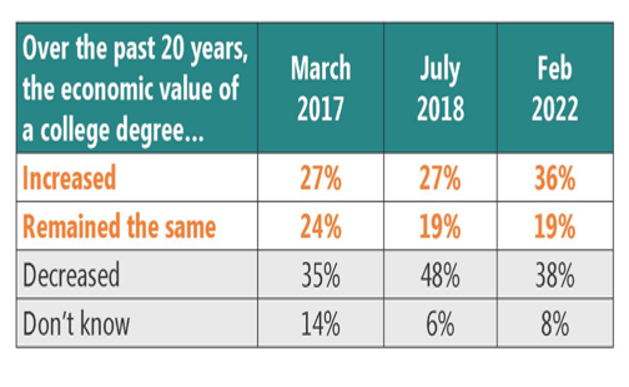
A recent poll conducted by the American Council on Education, however, provides more heartening news:
- Twice as many Americans (38 percent) said they believed higher education was “generally on the right track” as thought it was on the wrong track (19 percent).
- More than a third of respondents—36 percent—said they believed the economic value of a college degree had increased over the last 20 years, while 38 percent said it had decreased and 19 percent said it had remained the same.
- That’s a marked change from 2018, when 27 percent of respondents said the value had increased and 48 percent said it had decreased.
- Americans are evenly divided when asked if they believe most graduates are ready for the workforce, with 44 percent agreeing and 45 percent disagreeing. But asked a similar question in July 2018, 34 percent of Americans said they believed graduates were workforce ready, and 53 percent disagreed.
Improved Financial Outlook
According to the Association of Governing Boards of Universities and Colleges, between 2016 and February 2020, just before the pandemic, 92 nonprofit colleges and universities closed or announced that they would be closing or merging; and about ten percent of all higher education institutions faced market stresses so severe they were in similar danger.
Fast forward two years and, thanks largely to enormous sums of federal stimulus money, a soaring stock market for college investments, and careful crisis budget management, most colleges are in a much better place today than they were in 2020.
- According to the State Higher Education Executive Officers Association (SHEEO) annual “Grapevine Compilation of State Fiscal Support for Higher Education” for fiscal year 2022, state support has increased 9.6% nationally since 2020 and 21.3% since 2017, topping $100 billion for the first time.
- Standard and Poor’s Global upgraded their sector rating for colleges and universities from negative to stable for the first time in four years.
- College endowments shattered records last year: The average growth was 35% (compared to 1.8% in 2020). Nearly 20% of institutions now have endowments over $1 billion (though community colleges still tend to count theirs in the low millions).
- According to the Syntellis Performance Solutions 2022 CFO Outlook for Higher Education report, 72% of college Chief Financial Officers agreed that their institutions would be financially stable over the next five years (81% at public institutions).
This is not a time to be Pollyannish about the current and future state of American higher education: We face enormous financial, political, and cultural challenges in the years ahead, and to pretend otherwise would be foolishly irresponsible.
But overcoming those challenges is going to take a sense of common mission, strength forged in knowing what we do well and building on it, and a willingness to experiment, to innovate, to ride the waves of change toward an even brighter future for our colleges and our students.


